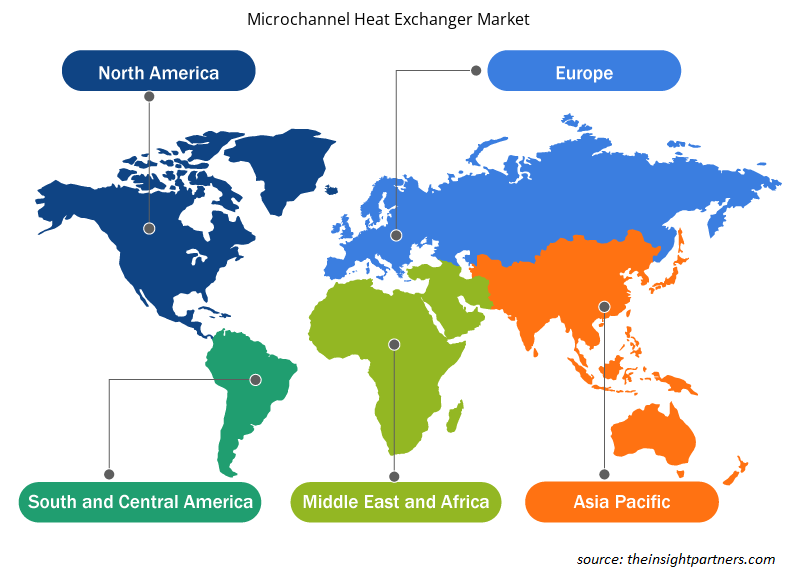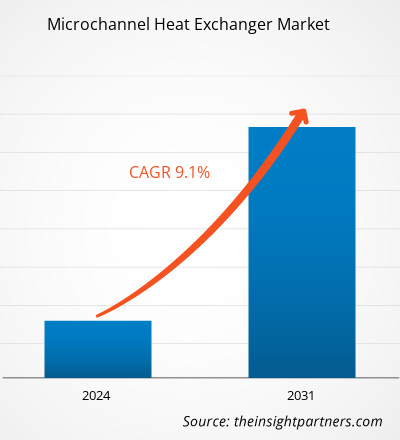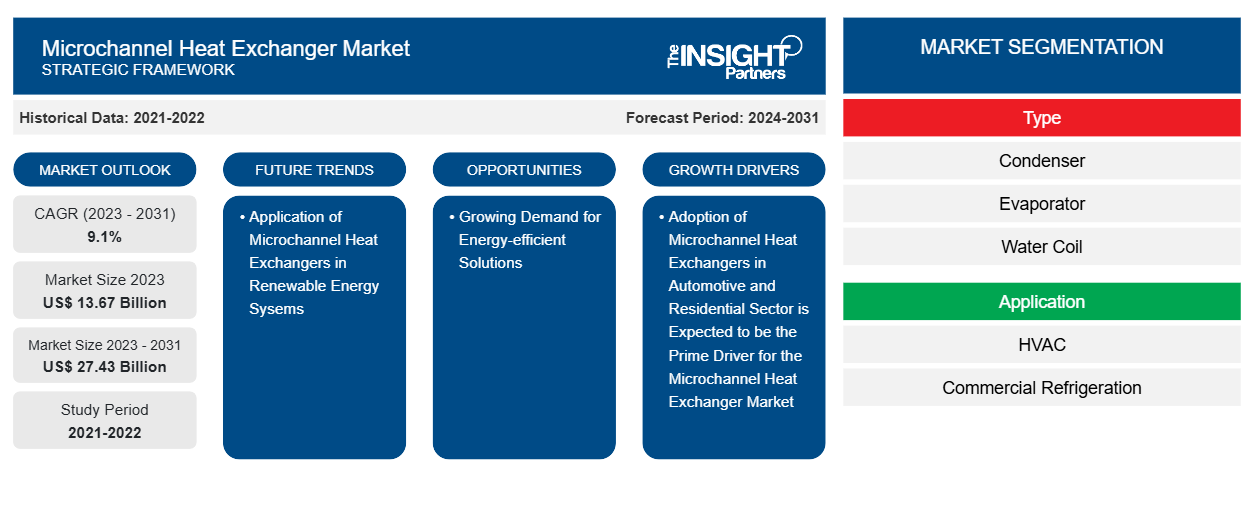마이크로채널 열교환기 시장 규모는 2023년 136억 7천만 달러에서 2031년까지 274억 3천만 달러에 도달할 것으로 예상됩니다. 이 시장은 2023~2031년에 9.1%의 CAGR을 기록할 것으로 예상됩니다. 마이크로채널 열교환기는 에너지 효율성과 냉매 충전량 감소 기능 덕분에 냉장 장비와 함께 주거 및 상업용 에어컨 시스템에 사용하기에 적합합니다. 마이크로채널 열교환기는 주로 난방 및 냉방 목적으로 사용됩니다. 자동차 산업의 발전은 마이크로채널 열교환기 시장의 주요 원동력으로 작용하고 있습니다.
마이크로채널 열교환기 시장 분석
마이크로채널 열교환기는 로켓 엔진, 터빈 블레이드, 하이브리드 자동차, 냉장 냉각, 수소 저장 , 미소 중력에서의 열 제어 및 모세관 펌프 루프와 같은 여러 응용 분야에서 활용할 수 있습니다. 열 플럭스 제거에 대한 요구 사항은 주로 응용 프로그램 유형에 따라 크게 달라집니다. 마이크로채널 열교환기의 응용 프로그램은 레이저 다이오드 및 핵융합, 고성능 컴퓨터 칩 및 핵분열로와 같은 소형 시스템에서 높은 열 플럭스를 제거하여 장수명으로 지속적인 성능을 확인하는 데 중요한 역할을 합니다.
마이크로채널 열교환기 시장 개요
마이크로채널 열교환기는 냉장 및 공조 시스템에 사용됩니다. 기술의 발전으로 세계는 소형화를 선호하고 있습니다. 따라서 소형 시스템에서 높은 열 플럭스를 제거하는 것이 중요해졌습니다. 시장은 유형과 응용 분야에 따라 분류됩니다. 유형에 따라 마이크로채널 열교환기 시장은 응축기, 증발기 및 수 코일로 분류됩니다. 응용 분야에 따라 시장은 HVAC, 상업용 냉장 및 기타로 나뉩니다.
귀하의 요구 사항에 맞게 이 보고서를 사용자 정의하세요
이 보고서의 일부 또는 국가 수준 분석, Excel 데이터 팩을 포함하여 모든 보고서에 대한 사용자 정의를 무료로 받을 수 있으며 신생 기업 및 대학을 위한 훌륭한 혜택과 할인 혜택을 이용할 수 있습니다.
- 이 보고서의 주요 시장 동향을 알아보세요.이 무료 샘플에는 시장 동향부터 추정 및 예측까지 다양한 데이터 분석이 포함됩니다.
마이크로채널 열교환기 시장 동인 및 기회
자동차 및 주거 부문에서 마이크로채널 열교환기 채택이 마이크로채널 열교환기 시장의 주요 원동력이 될 것으로 예상됨
자동차 및 주거용 에어컨에서 마이크로채널 열교환기의 적용이 확대되면서 마이크로채널 열교환기 시장이 주요 성장 동력으로 작용하고 있습니다. 마이크로채널 열교환기는 주로 주거용 에어컨의 경우 기존의 핀 앤 튜브 열교환기보다 효율적이라고 여겨집니다. 마이크로채널 열교환기는 주거용 에어컨 시스템에서 냉매 양을 줄이는 데 도움이 되어 에너지 효율을 높이는 데 도움이 됩니다. 마이크로채널 열교환기는 자동차 분야의 전자 장비 냉각에 적용됩니다. 소형화 및 컴팩트한 장치에 대한 수요가 증가함에 따라 마이크로채널 열교환기는 자동차 에어컨 시스템에 사용하기에 완벽하게 적합해졌습니다.
에너지 효율적 솔루션에 대한 수요 증가
최근 들어 에너지 효율적인 가전제품에 대한 소비자의 선호도가 증가하고 있습니다. 에너지 효율성은 새로운 인프라에 투자할 필요성을 낮춰 전반적인 전기 수요를 줄임으로써 장기적인 이점을 제공할 수 있습니다. 에너지 효율성을 달성하기 위해 많은 최종 사용자 산업에서 고에너지 효율적인 에어컨 및 냉매 시스템을 사용하고 있습니다. 에너지 효율적인 냉장 및 에어컨 시스템은 기존 시스템보다 에너지를 덜 사용하고 더 효과적으로 작동하여 탄소 발자국을 줄입니다. 에너지 효율적인 냉매 및 냉각 시스템은 주거, 상업 및 산업 시설에서 에너지 비용과 온실 가스 배출을 줄이는 데 사용할 수 있습니다. 따라서 에너지 효율적인 솔루션에 대한 수요가 증가함에 따라 마이크로채널 열교환기 시장의 진화가 촉진됩니다.
마이크로채널 열교환기 시장 보고서 세분화 분석
마이크로채널 열교환기 시장 분석에 기여한 주요 세그먼트는 유형과 응용 분야입니다.
- 유형별로 시장은 응축기, 증발기, 워터 코일로 구분되었습니다. 응축기 세그먼트는 2023년에 더 큰 시장 점유율을 차지했습니다.
- 응용 프로그램 측면에서 시장은 HVAC, 상업용 냉장 및 기타로 세분화되었습니다. HVAC 세그먼트는 2023년에 시장을 지배했습니다.
지리적 지역별 마이크로채널 열교환기 시장 점유율 분석
마이크로채널 열교환기 시장 보고서의 지리적 범위는 주로 북미, 유럽, 아시아 태평양, 중동 및 아프리카, 남미의 5개 지역으로 나뉩니다.
아시아 태평양 지역은 2023년 마이크로채널 열교환기 시장을 선도했습니다. 아시아 태평양 지역에는 중국, 인도, 호주, 일본, 한국이 포함됩니다. 자동차 및 HVAC 회사의 높은 입지가 시장의 주요 원동력으로 작용하고 있습니다. 마이크로채널 열교환기에서 운영되는 제조 회사는 자동차 및 주거 부문에 보다 컴팩트한 솔루션을 제공하여 제품 제공을 확대하는 데 주력하고 있습니다. 에어컨 시스템의 에너지 효율을 높이기 위한 마이크로채널 열교환기의 통합도 시장의 주요 원동력으로 작용하고 있습니다. 냉장 및 냉각 시스템을 위한 환경 친화적 옵션에 대한 관심이 커지면서 마이크로채널 열교환기의 적용도 증가하고 있으며, 이는 아시아 태평양에서 예측 기간 동안 시장 진화를 주도할 것으로 추정됩니다.
마이크로채널 열교환기 시장 지역 통찰력
Insight Partners의 분석가들은 예측 기간 동안 마이크로채널 열교환기 시장에 영향을 미치는 지역적 추세와 요인을 철저히 설명했습니다. 이 섹션에서는 북미, 유럽, 아시아 태평양, 중동 및 아프리카, 남미 및 중미의 마이크로채널 열교환기 시장 세그먼트와 지리에 대해서도 설명합니다.

- 마이크로채널 열교환기 시장에 대한 지역별 특정 데이터 얻기
마이크로채널 열교환기 시장 보고서 범위
| 보고서 속성 | 세부 |
|---|---|
| 2023년 시장 규모 | 136억 7천만 달러 |
| 2031년까지 시장 규모 | 274억 3천만 달러 |
| 글로벌 CAGR (2023-2031) | 9.1% |
| 역사적 데이터 | 2021-2022 |
| 예측 기간 | 2024-2031 |
| 다루는 세그먼트 | 유형별로
|
| 포함된 지역 및 국가 | 북아메리카
|
| 시장 선도 기업 및 주요 회사 프로필 |
|
시장 참여자 밀도: 비즈니스 역학에 미치는 영향 이해
마이크로채널 열교환기 시장은 소비자 선호도의 변화, 기술 발전, 제품의 이점에 대한 인식 증가와 같은 요인으로 인해 최종 사용자 수요가 증가함에 따라 빠르게 성장하고 있습니다. 수요가 증가함에 따라 기업은 제품을 확장하고, 소비자의 요구를 충족하기 위해 혁신하고, 새로운 트렌드를 활용하여 시장 성장을 더욱 촉진하고 있습니다.
시장 참여자 밀도는 특정 시장이나 산업 내에서 운영되는 회사나 기업의 분포를 말합니다. 주어진 시장 공간에 얼마나 많은 경쟁자(시장 참여자)가 존재하는지 그 규모나 총 시장 가치에 비해 나타냅니다.
마이크로채널 열교환기 시장에서 운영되는 주요 회사는 다음과 같습니다.
- API 열전달 주식회사
- 클라이메탈 SL
- 댄포스
- 덴소 주식회사
- 하논시스템즈
- 칼트라
면책 조항 : 위에 나열된 회사는 어떤 특별한 순서에 따라 순위가 매겨지지 않았습니다.

- 마이크로채널 열교환기 시장 주요 업체 개요를 알아보세요
마이크로채널 열교환기 시장 뉴스 및 최근 개발
마이크로채널 열교환기 시장은 1차 및 2차 조사 이후의 정성적, 정량적 데이터를 수집하여 평가되며, 여기에는 중요한 기업 간행물, 협회 데이터 및 데이터베이스가 포함됩니다. 다음은 마이크로채널 열교환기 시장과 전략에 대한 시장의 개발 목록입니다.
- 2024년 4월, 칼트라는 마이크로채널 열교환기용으로 내식성이 뛰어난 알루미늄 합금 AA3F05, 템퍼 H112를 출시했습니다. (출처: 칼트라, 보도자료/회사 웹사이트/뉴스레터)
- 2024년 2월, Danfoss India는 ACREX India 2024 전시회에서 마이크로채널 열교환기 기술을 선보였습니다. 에너지 효율적인 이 기술은 기존의 핀 튜브 열교환기보다 더 높은 이점을 제공하는 고급 차세대 증발기로 공랭식 장치를 완전히 변형합니다. (출처: Danfoss, 보도자료/회사 웹사이트/뉴스레터)
마이크로채널 열교환기 시장 보고서 범위 및 제공물
"마이크로채널 열교환기 시장 규모 및 예측(2021-2031)" 보고서는 아래 영역을 포괄하는 시장에 대한 자세한 분석을 제공합니다.
- 범위에 포함된 모든 주요 시장 세그먼트에 대한 글로벌, 지역 및 국가 수준의 시장 규모 및 예측
- 동인, 제약 및 주요 기회와 같은 시장 역학
- 주요 미래 트렌드
- 자세한 PEST 분석
- 주요 시장 동향, 주요 업체, 규정 및 최근 시장 동향을 포괄하는 글로벌 및 지역 시장 분석
- 시장 집중도, 히트맵 분석, 유명 기업 및 최근 개발 사항을 포함하는 산업 환경 및 경쟁 분석
- SWOT 분석을 통한 자세한 회사 프로필
- 과거 분석(2년), 기준 연도, CAGR을 포함한 예측(7년)
- PEST 및 SWOT 분석
- 시장 규모 가치/거래량 - 글로벌, 지역, 국가
- 산업 및 경쟁 환경
- Excel 데이터세트
최근 보고서
관련 보고서
사용 후기
구매 이유
- 정보에 기반한 의사 결정
- 시장 역학 이해
- 경쟁 분석
- 고객 인사이트
- 시장 예측
- 위험 완화
- 전략 기획
- 투자 타당성 분석
- 신흥 시장 파악
- 마케팅 전략 강화
- 운영 효율성 향상
- 규제 동향에 발맞춰 대응





















 무료 샘플 받기 - 마이크로채널 열교환기 시장
무료 샘플 받기 - 마이크로채널 열교환기 시장